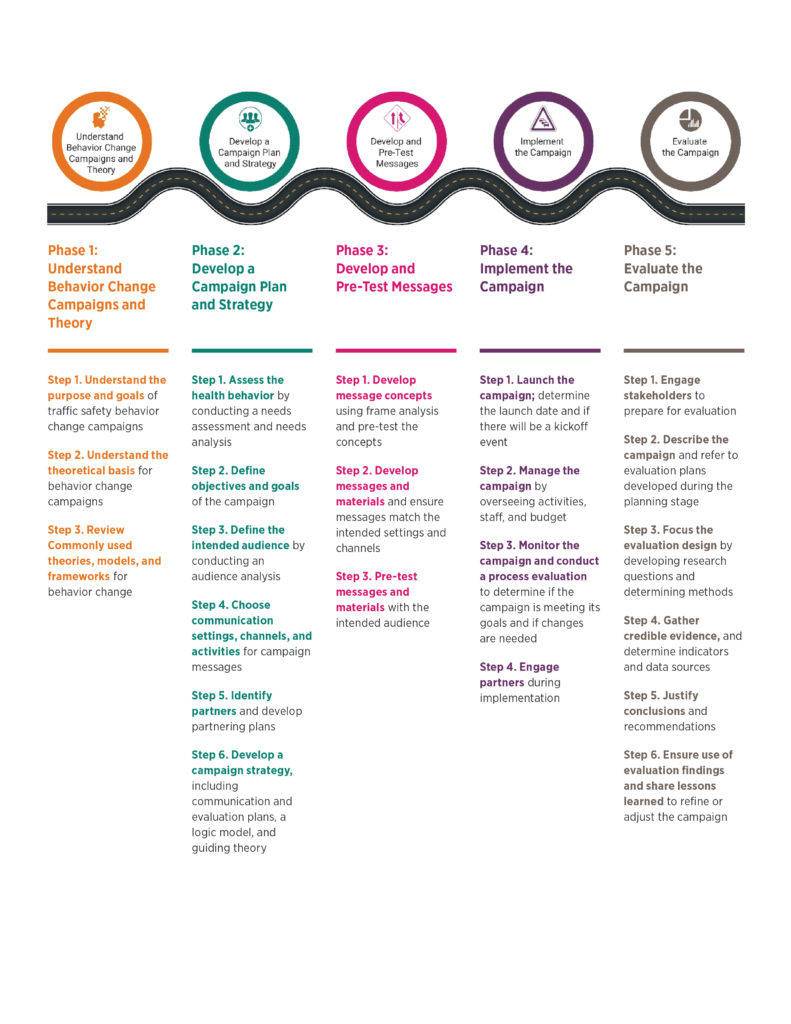
Evidence-Based Behavior Change Campaigns to Improve Traffic Safety Toolkit
The Evidence-Based Behavior Change Campaigns to Improve Traffic Safety Toolkit is a hands-on resource designed for traffic safety practitioners to develop behavior change campaigns that are both evidence-based and effective.
March 2020
Suggested Citation
Abstract
Introduction
Preventing traffic-related injuries and fatalities requires targeted interventions that promote safe behaviors and deter unsafe behaviors among road users. Behavior change campaigns are one strategy for reducing the risk factors associated with traffic injuries and fatalities. Behavior change campaigns are a planned set of activities, involving organized communication, and are implemented over a period of time to persuade people to modify their behavior.
This project provides traffic safety practitioners hands-on resources to develop evidence-based and effective behavior change campaigns including the Evidence Based-Behavior Change Campaigns to Improve Traffic Safety Toolkit and a corresponding research brief that describes the methods of and findings from the development of the Toolkit.
Overview of the Toolkit
The Evidence-Based Behavior Change Campaigns to Improve Traffic Safety Toolkit includes information and resources to help traffic safety practitioners plan, design, implement, and evaluate behavior change campaigns. The toolkit combines evidence-based examples and lessons learned from professionals in the fields of traffic safety, behavior change, and public health.
Contents of the Toolkit. The Evidence-Based Behavior Change Campaigns to Improve Traffic Safety Toolkit is comprised of a roadmap – a one page overview of the toolkit phases and steps (see below) – and detailed information about each corresponding step.
Supplemental resources include references for the toolkit (Appendix A), a complete checklist of activities by phase (Appendix B), case studies of four evidence-based and effective behavior change campaigns (Appendix C), and additional examples of evidence-based and effective behavior change campaigns (Appendix D).
The Toolkit describes five phases to help practitioners develop a campaign:
- Understand behavior change campaigns and theory
- Develop a campaign plan and strategy
- Develop and pre-test messages
- Implement the campaign
- Evaluate the campaign
Each of the phases consists of multiple steps, and each step describes required activities. Each phase also includes a short checklist of important considerations.
Methodology
An environmental scan and key informant interviews were conducted to develop the Evidence-Based Behavior Change Campaigns to Improve Traffic Safety Toolkit. A research brief was developed describing the methods and results of the project.
The literature review was conducted using the PubMed database for peer-reviewed, scientific literature to identify evidence-based and effective behavior change campaigns in the traffic safety and public health fields. The search combined keywords related to 1) campaigns, 2) evaluation, 3) public health topic areas of interest including traffic safety, tobacco cessation, cancer prevention, and HIV/AIDS prevention; and 4) risk factors associated with traffic injuries and fatalities (e.g., “seat belt use” and “distracted”). From this search, the research team determined whether the campaigns were evidence-based or effective using three criteria:
- Publication of evidence: Campaign evaluation findings were reported in at least one peer-reviewed journal article that described the evaluation and documented successful behavior change outcomes;
- Evidence of effectiveness: The campaign produced positive behavior changes using clearly stated outcome measures; and
- Evaluation design: The campaign evaluation used a rigorous design and, to the extent possible, objective measures to gather credible evidence of campaign effectiveness.
Following the literature review and environmental scan, one-hour, semi-structured telephone interviews were conducted with 20 professionals with expertise in traffic safety, behavior change campaign design and implementation, evaluation, and/or health communication. The purpose of the interviews was to gather relevant information, best practices, lessons learned, and resources for the toolkit.
Results
The Evidence-Based Behavior Change Campaigns to Improve Traffic Safety Toolkit includes a roadmap for practitioners (Figure 1) and describes the five phases for developing behavior change campaigns:
Figure 1. Evidence-Based Behavior Change Campaigns to Improve Traffic Safety: A Roadmap for Practitioners

Suggested Citation